48 posts
Latest Posts by verginia-blog1 - Page 2
First signs of weird quantum property of empty space?

A team led by Roberto Mignani from INAF Milan (Italy) and from the University of Zielona Gora (Poland), used ESO’s Very Large Telescope (VLT) at the Paranal Observatory in Chile to observe the neutron star RX J1856.5-3754, about 400 light-years from Earth [1].
Despite being amongst the closest neutron stars, its extreme dimness meant the astronomers could only observe the star with visible light using the FORS2 instrument on the VLT, at the limits of current telescope technology.
Neutron stars are the very dense remnant cores of massive stars – at least 10 times more massive than our Sun – that have exploded as supernovae at the ends of their lives. They also have extreme magnetic fields, billions of times stronger than that of the Sun, that permeate their outer surface and surroundings.
These fields are so strong that they even affect the properties of the empty space around the star. Normally a vacuum is thought of as completely empty, and light can travel through it without being changed. But in quantum electrodynamics (QED), the quantum theory describing the interaction between photons and charged particles such as electrons, space is full of virtual particles that appear and vanish all the time. Very strong magnetic fields can modify this space so that it affects the polarisation of light passing through it.
Mignani explains: “According to QED, a highly magnetised vacuum behaves as a prism for the propagation of light, an effect known as vacuum birefringence.”
Among the many predictions of QED, however, vacuum birefringence so far lacked a direct experimental demonstration. Attempts to detect it in the laboratory have not yet succeeded in the 80 years since it was predicted in a paper by Werner Heisenberg (of uncertainty principle fame) and Hans Heinrich Euler.
“This effect can be detected only in the presence of enormously strong magnetic fields, such as those around neutron stars. This shows, once more, that neutron stars are invaluable laboratories in which to study the fundamental laws of nature.” says Roberto Turolla (University of Padua, Italy).
After careful analysis of the VLT data, Mignani and his team detected linear polarisation – at a significant degree of around 16% – that they say is likely due to the boosting effect of vacuum birefringence occurring in the area of empty space surrounding RX J1856.5-3754 [2].
Vincenzo Testa (INAF, Rome, Italy) comments: “This is the faintest object for which polarisation has ever been measured. It required one of the largest and most efficient telescopes in the world, the VLT, and accurate data analysis techniques to enhance the signal from such a faint star.”
“The high linear polarisation that we measured with the VLT can’t be easily explained by our models unless the vacuum birefringence effects predicted by QED are included,” adds Mignani.
“This VLT study is the very first observational support for predictions of these kinds of QED effects arising in extremely strong magnetic fields,” remarks Silvia Zane (UCL/MSSL, UK).
Mignani is excited about further improvements to this area of study that could come about with more advanced telescopes: “Polarisation measurements with the next generation of telescopes, such as ESO’s European Extremely Large Telescope, could play a crucial role in testing QED predictions of vacuum birefringence effects around many more neutron stars.”
“This measurement, made for the first time now in visible light, also paves the way to similar measurements to be carried out at X-ray wavelengths,” adds Kinwah Wu (UCL/MSSL, UK).
This research was presented in the paper entitled “Evidence for vacuum birefringence from the first optical polarimetry measurement of the isolated neutron star RX J1856.5?3754”, by R. Mignani et al., to appear in Monthly Notices of the Royal Astronomical Society.
European Southern Observatory
Интересно

Ancient rocks hold evidence for life before oxygen http://www.geologypage.com/2016/11/ancient-rocks-hold-evidence-life-oxygen.html
Ивтересно




PEOPLE OF THE ANCIENT WORLD: Lucius Verus (Marcus Aurelius’ Co-Emperor)
LUCIUS Verus (161-169 CE) was Marcus Aurelius’ adopted brother and co-emperor, a man whose time on the throne is overshadowed by the reign of the last of the Five Good Emperors.
In the final years of the Pax Romana, a period of almost two centuries of relative peace and stability following the rule of Augustus, a young Stoic philosopher, Marcus Aurelius, came to the throne in 161 CE, and for the first time in the empire’s short history he chose to have someone rule at his side; his adopted brother Lucius Verus.
The future emperor Lucius Ceionius Commodus was born in 130 CE and raised in Rome, the eldest son of the one-time consul Lucius Aelius Caesar.
Read More
Article by Donald L. Wasson on AHE









Pulsars: How The First ‘False Alien’ Signal Opened Up A New World In Astronomy
“In 1967, a radio source emitting regular, 0.04-second long pulses every 1.3373 seconds was found for the first time using a scintillation array. After the “noise” explanation was ruled out, the next thing people turned towards were intelligent extraterrestrials. There was no natural mechanism in existence that would have explained it at that time, so turning to aliens was logical, if ultimately incorrect.”
Observations that surprise us, of a phenomenon we weren’t expecting and don’t have an explanation for, are some of the most exciting things we can encounter in astronomy. In 1967, regularly pulsing radio sources, discovered without any expectation, provided exactly that. It wasn’t noise; it was definitely a robust, repeatable observation; so what was it? While our imaginations might have run to aliens initially, further developments quickly showed that this was a ball of rapidly rotating neutrons, more massive than even the Sun but only a few kilometers in diameter. These pulsars, as they’re now know, are ubiquitous and come about from the corpses of core-collapse supernova. Could this be a harbinger of what we can expect from the ‘alien megastructure’ controversy?
Come find out how the first ‘false alien’ signal from astronomy opened up a whole new field of science for us to investigate!
😊
Archaeologists Discover Unknown Fortress Walls, Byzantine Gold Coin

Two unknown fortress walls and three unknown fortress towers as well as a 14th century Byzantine gold coin have been discovered by archaeologists during the 2016 excavations of the major medieval fortress of Rusocastro in today’s Southeast Bulgaria.
The Rusocastro Fortress is best known for the Battle of Rusocastro in 1332 AD. It was the last big military victory of the medieval Bulgarian Empire before it was conquered by the invading Ottoman Turks at the end of the 14th century.
It was also the last major battle of the seven-century-long Bulgarian-Byzantine Wars for domination of the Balkan Peninsula (lasting from the 7th until the 14th century), which ended when, weakened by their hostilities against one another, among other factors, Bulgaria and Byzantium were both conquered by the Ottoman Turkish invaders at the end of the 14th and the beginning of the 15th century. Read more.




November 14, 1969 – Thirty-six-and-a-half seconds after the launch of Apollo 12, the space vehicle triggered a lightning discharge through itself and down to the earth through the Saturn’s ionized plume. Protective circuits on the fuel cells in the Service Module falsely detected overloads and took all the fuel cells offline, as well as much of the Command/Service Module instrumentation. At 52 seconds after liftoff, a second strike knocked out the “8-ball” attitude indicator. The telemetry stream at Mission Control was garble, but Apollo 12 continued to fly correctly. The strikes had not affected the Saturn V rocket’s Instrument Unit.
000:09:02 Conrad (onboard): I think we got hit by lightning.
000:09:04 Gordon Bean (onboard): I do, too.
000:09:06 Gordon (onboard): Something took care of those panels, I’ll say that for it.
Pete Conrad from the 1969 technical debrief: “Because I could see outside, I made the comment to them several times. I told the ground that I thought we had been hit by lightning. I was the only one that had any outside indications. Dick didn’t note anything over his little hole in his center window. I was the only one who noticed anything and that was only the first time. I was aware that something external to the spacecraft had happened. I had the decided impression that I not only saw it, but felt it and heard it.”
Alan Bean from the 1969 technical debrief: “I knew we had power, so I didn’t want to make any changes. I figured we could fly into orbit just like that and that’s exactly what we did. The ground came up a little later and said to put the fuel cells back on the line. I was a little hesitant about doing that, because I didn’t understand that we had been hit by lightning. I gave it a go and, sure enough, things started working very well after that.”
(NASA/Wikipedia/NASA)

Yowah Koroit Boulder Opal | #Geology #GeologyPage #Opal #Mineral
83.10Ct Natural Australian Queensland Yowah Koroit Boulder Opal
Dimensions (mm): 37.5 x 18.3 x 12mm
Locality: Queensland, Australia
Photo Copyright © opalauctions
Geology Page www.geologypage.com
😊

Patagonian fossil leaves reveal rapid recovery from dinosaur extinction event http://www.geologypage.com/2016/11/patagonian-fossil-leaves-reveal-rapid-recovery-dinosaur-extinction-event.html
😊

A giant predatory lizard swam in Antarctic seas near the end of the dinosaur age http://www.geologypage.com/2016/11/giant-predatory-lizard-swam-antarctic-seas-near-end-dinosaur-age.html
X
![The Eight Planets Of Our Solar System Image Credits: [x]](https://64.media.tumblr.com/6d49a7f8ffbda05a76e0f70e827669af/tumblr_ngr4saUA4s1r6mt8go1_500.png)
![The Eight Planets Of Our Solar System Image Credits: [x]](https://64.media.tumblr.com/9b36e80a8801d1ce79804b8f592834cb/tumblr_ngr4saUA4s1r6mt8go2_500.png)
![The Eight Planets Of Our Solar System Image Credits: [x]](https://64.media.tumblr.com/40d82a05ee3b6cd89020241cdfd4c571/tumblr_ngr4saUA4s1r6mt8go3_500.png)
![The Eight Planets Of Our Solar System Image Credits: [x]](https://64.media.tumblr.com/188dd05ddbfe5f4e4968c9a7475640c9/tumblr_ngr4saUA4s1r6mt8go4_500.png)
![The Eight Planets Of Our Solar System Image Credits: [x]](https://64.media.tumblr.com/f04e1b4d1e0cc136170b5f21f9c74396/tumblr_ngr4saUA4s1r6mt8go6_500.png)
![The Eight Planets Of Our Solar System Image Credits: [x]](https://64.media.tumblr.com/d094d6d12ffb8b88b680bdc5bd2c3a3d/tumblr_ngr4saUA4s1r6mt8go5_500.png)
![The Eight Planets Of Our Solar System Image Credits: [x]](https://64.media.tumblr.com/8d109f5968bcdae1ae932ffa88a87786/tumblr_ngr4saUA4s1r6mt8go7_500.png)
![The Eight Planets Of Our Solar System Image Credits: [x]](https://64.media.tumblr.com/58a59d4e5ce0935862fd96c136102c1c/tumblr_ngr4saUA4s1r6mt8go8_500.png)
The eight planets of our solar system image credits: [x]
D

Space station flyover of Gulf of Aden and Horn of Africa
European Space Agency astronaut Samantha Cristoforetti took this photograph from the International Space Station and posted it to social media on Jan. 30, 2015. Cristoforetti wrote, “A spectacular flyover of the Gulf of Aden and the Horn of Africa. #HelloEarth”
Image credit: NASA/ESA/Samantha Cristoforetti

Celestial nomad takes centre stage
In this new ESO image, nightfall raises the curtain on a theatrical display taking place in the cloudless skies over La Silla.
In a scene humming with activity, the major players captured here are Comet Lovejoy, glowing green in the centre of the image; the Pleiades above and to the right; and the California Nebula, providing some contrast in the form of a red arc of gas directly to the right of Lovejoy.
A meteor adds its own streak of light to the scene, seeming to plunge into the hazy pool of green light collecting along the horizon.
The telescopes of La Silla provide an audience for this celestial performance, and a thin shroud of low altitude cloud clings to the plain below the observatory streaked by the Panamericana Highway.
Comet Lovejoy’s long tail is being pushed away from the comet by the solar wind. Carbon compounds that have been excited by ultraviolet radiation from the Sun give it its striking green hue.
This is the first time the comet has passed through the inner Solar System and ignited so spectacularly in over 11 000 years. Its highly elliptical orbit about the Sun — adjusted slightly due to meddling planets — means that it will not grace our skies for another 8000 years once it has rounded the Sun and begun its lonely voyage back into the cold outer regions of the Solar System.
Image credit: P. Horálek/ESO
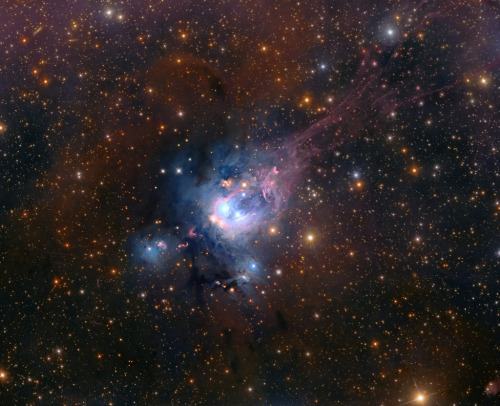
NGC 7129
Nice




This shows a valid method for computing square roots without using a calculator, and can be used to solve this question. This document was written by Prof. Jeff Forshaw
Nice
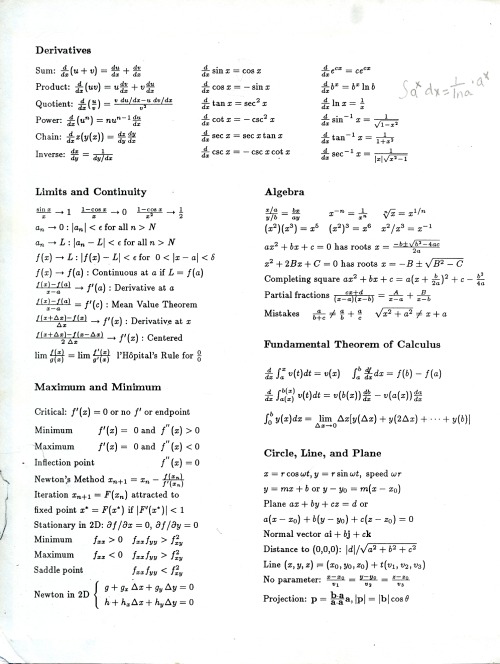
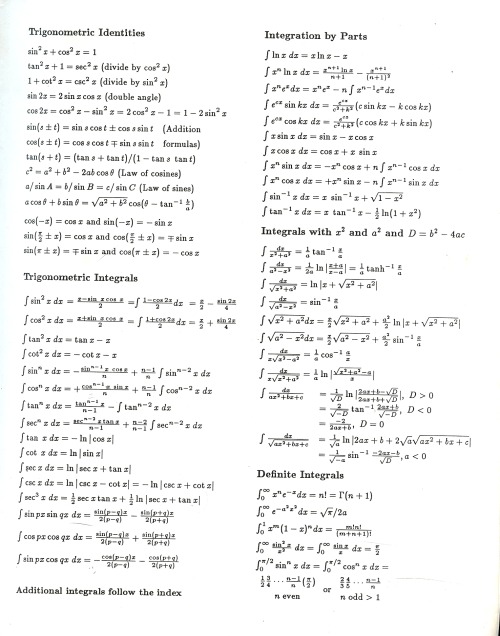
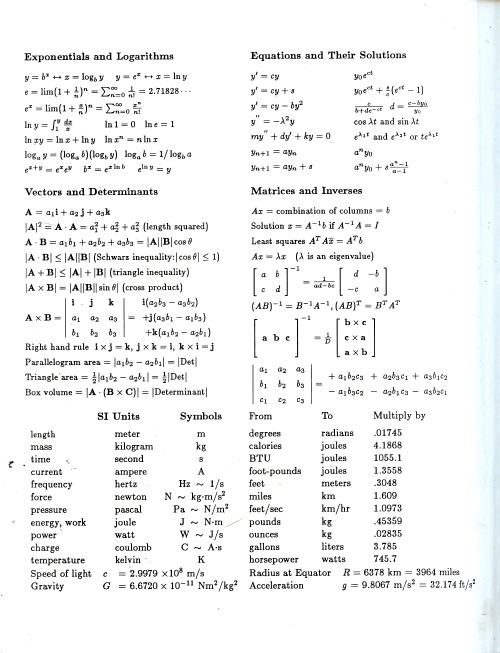
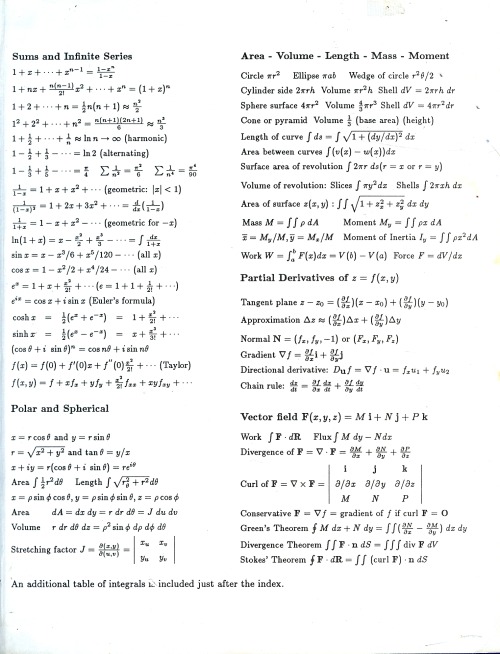
Scans of the inside covers of Strang’s Calculus, which you can legally-download for free here from the MIT website. This is my all-time favorite math or physics textbook. Scanned it so I could cut and paste it into my new sketchbook, wanna try and make a ~cool artistic~ reference poster out of it, ‘cuz I’ve been real into that idea since I took notes about rings for the algebra midterm on a big piece of watercolor paper.


A very neat visual proof for the formula of the first n square numbers.
Correction: as pointed out by @othermaterial, the right-hand side of the formula should have variables n instead of k.
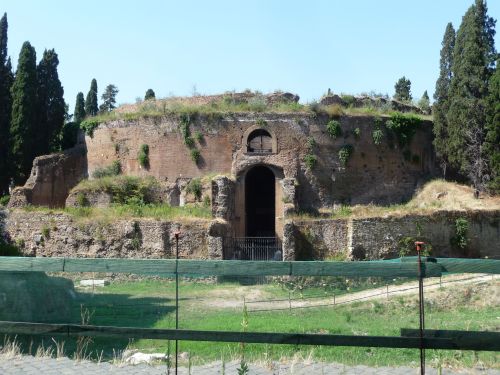
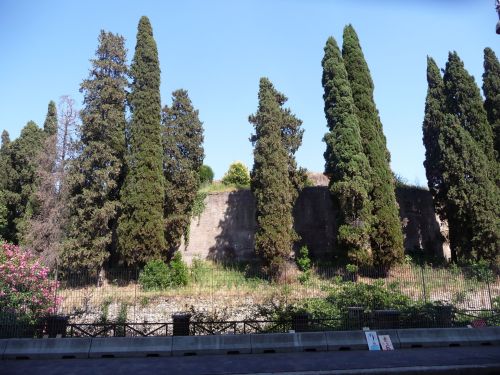
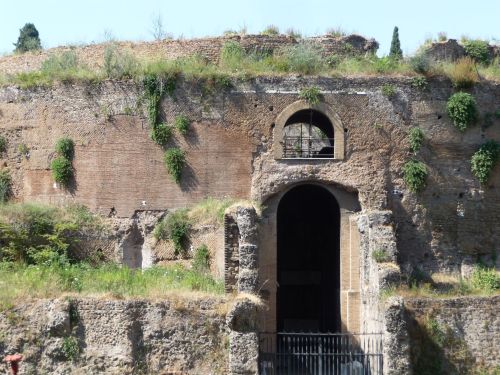
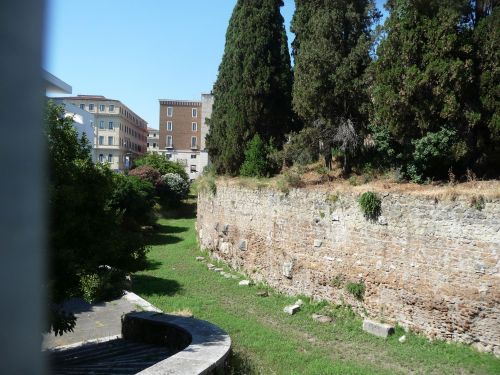
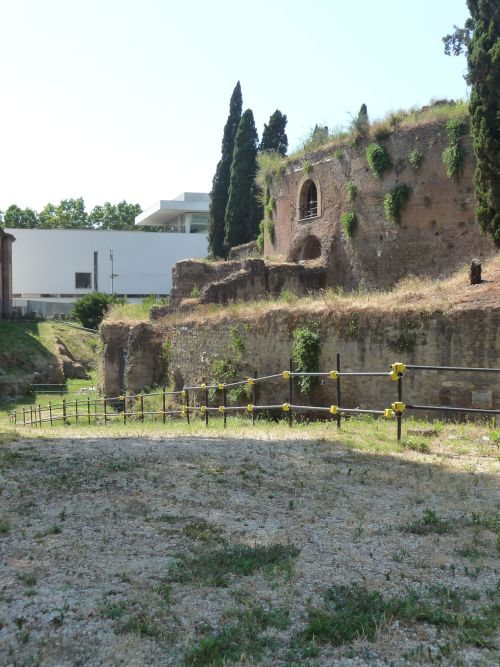

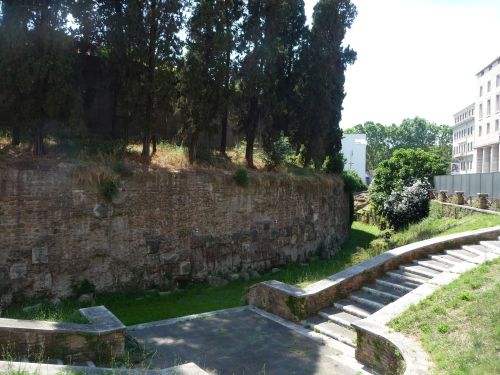
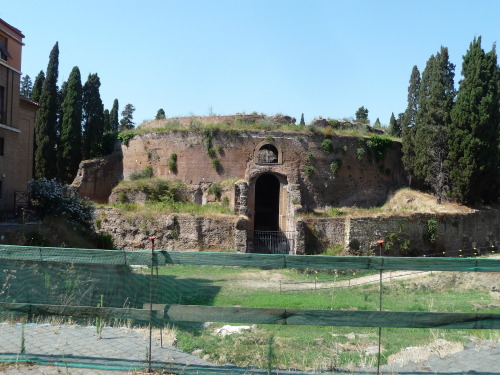
Mausoleum of Augustus
Rome, July 2015







New Impact Hypothesis Might Explain Our Moon’s Uniqueness
“This also helps explain some nice oddities all in one go. “What’s beautiful about this work is that we can end up with the current state of the moon — its orbit, its chemistry — with just one step, without invoking any other event,” says Sarah Stewart, a coauthor on the study. If the Earth rotated on its axis before the impact, and if the protoplanet that collided with Earth were in the Earth-Sun plane, none of this would be possible. But with this, we not only get a rapidly spinning young Earth and a 24-hour, 23.5º tilted Earth today, but a Moon that orbits out of the plane, nearly locked to the Sun rotationally, and locked to the Earth revolution-wise. The pieces all fall together beautifully.”
Why is our Moon so unlike every other moon in the Solar System? No other moon is such a large percent of its parent planet’s mass or size; no other moon rotates so far afield of its planet’s rotational axis; no other moon orbits so far out of the planet-Sun plane. Yet our Moon does it all. The giant impact hypothesis might explain why the Moon is made of the same material as Earth, but wouldn’t explain these features. Unless, that is, the giant impact occurred with a very large velocity out of the plane of proto-Earth’s orbit. Unless, again, the Earth weren’t rotating at 23.5º prior to the impact. This new tweak on the impact hypothesis, put forth by a team of authors earlier this week in the journal Nature, might explain the unique history of the Earth-Moon system, including some features we don’t normally think about as being puzzling.
It isn’t just Earth that’s unique in our Solar System, but the Moon as well. Combined, the great cosmic detective story might have a new lead suspect!